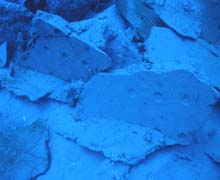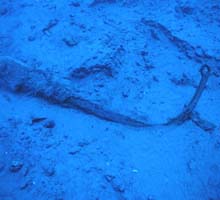
Concretion on the ocean floor clearly shows indentations from the rivets that still hold the turret's iron plates together. Click image for larger view and detailed explanation.

NOAA divers already have found two additional stanchions from the Monitor's turret, one of which is shown here. Click image for larger view and detailed explanation.
Dives Continue at the Monitor Site
July 3, 2002
August 11, 2002
Tane Casserley
Archaeologist
Monitor National Marine Sanctuary
On Saturday, August 10, 2002, even as hundreds of onlookers cheered the arrival of the Monitor’s 120-ton turret at The Mariners’ Museum, a team of NOAA divers was revisiting the Monitor’s watery grave. Divers from East Carolina University and the National Undersea Research Center at the University of North Carolina at Wilmington and I were the first to see the Monitor without its revolutionary revolving gun turret.
Forty fathoms deep, the warm blue waters of the Gulf Stream now illuminate a large sandy emptiness. The place where the turret sat for 140 years is now a 30-foot void. Surrounding the hole are the remains of armor belt and decking—the exposed oak beams and iron plating that put up such a fight against the Navy divers trying to cut the turret free. Pieces of concretion that once embraced the outside of the circular turret have fallen into the hole. Many of them still carry the indentation marks of the rivets that held the turret’s iron plates together.
For the next week, the NOAA team will continue to dive from the Research Vessel Cape Fear. Because of the challenging depth of the Monitor, divers use decompression techniques and breathe Trimix, a combination of helium, oxygen and nitrogen. They will document the changes made to the site using video, still photography and archaeological mapping techniques. They will also recover any artifacts that may have been exposed during the lifting of the turret. In fact, divers have already located two stanchions from the turret. These are the iron rods that supported the canvas canopy of the turret that helped to protect the Monitor’s crew from the elements.
Without the Monitor’s signature feature in place, divers must reorient themselves to the site. The divers are also battling the same environmental conditions that hampered the Navy’s massive mission this summer, and of course, the same conditions that helped sink the Monitor on that stormy New Year’s Eve night in 1862. With currents up to two knots, divers must use every hand available. While attempting to map the site, one hand is on the tape measure and the other dug into the sand, gripping the sediment to keep from being swept away from the wreck site by the current.
The divers will help prepare for future excavations on the site by placing a protective plastic covering over the area where the turret once sat. This will help distinguish the untouched layer underneath from any modern sediment that fills in on top. This will not be the last summer of dives to the site. There is still much to explore, hundreds of artifacts to uncover, and dozens of stories yet to be told from the Monitor National Marine Sanctuary.
Sign up for the Ocean Explorer E-mail Update List.

































